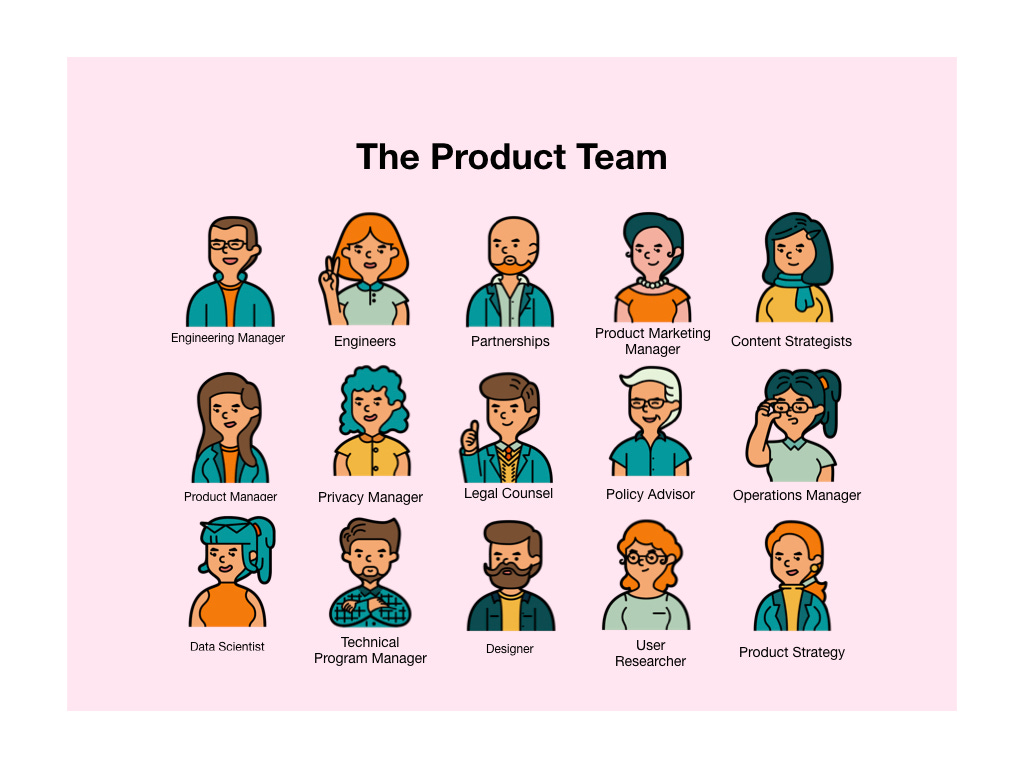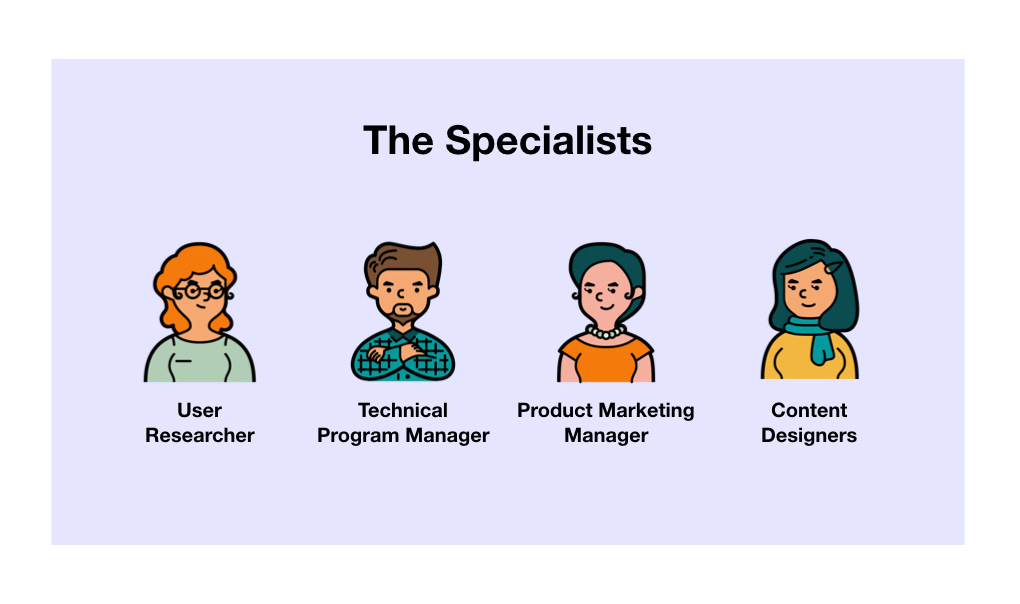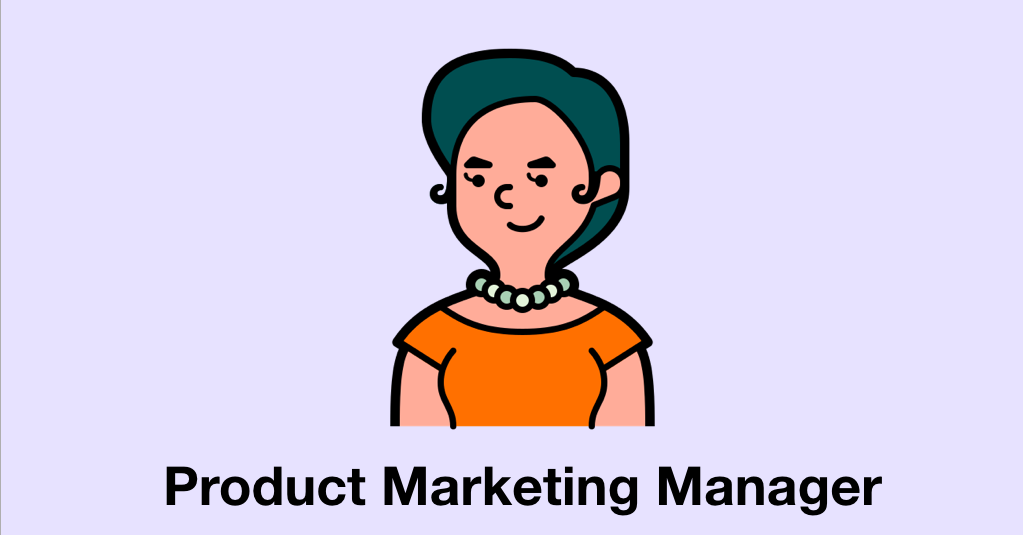15 Roles in Tech That You Need to Know
Meet the team behind your feed - including content strategists, privacy managers and product managers
Who builds products?
A few years ago, my answer would have been simple: engineers, designers and product managers. This was true in the tech scene I was familiar with — startups, hackathons and smaller tech companies.
But as I started working on more complicated projects at larger companies, I realized many more people are involved in launching successful products.
Today, I want to share how a product team is structured and what roles help to build products. Knowing these things has two distinct benefits:
Uncover opportunities: Everyone knows about product managers and engineers, but there are incredible opportunities in other fields. This is especially true for people with non-technical backgrounds who want to enter tech.
Empathy: If you're actively building products, it’s important to understand and appreciate what each of your colleagues does.
Let’s start with the structure of the product team.
From my experience, there are three layers of people: the core team, specialists and professionals.
Core Team: the main builders for a given product. They decide the product strategy, build all its necessary features and are responsible for its success.
This group includes Engineers, Engineering Managers, Product Managers, Designers, Data Scientists.
Specialists: experts that join a core team when their expertise is needed over a long period of time. They are responsible for ensuring their vertical succeeds.
This group includes Product Marketing Managers, Content Designers, User Researchers, Technical Program Managers.
Professionals: domain experts that help core teams navigate external systems. They work with multiple teams in parallel.
This includes Partnership Managers, Legal Counsels, Policy Advisors, Operations Managers, Privacy Managers and Product Strategists.
Let's dive into each section and profile the roles.
Three notes before we start:
This is based mostly on my experience at Big Tech companies (Facebook, Microsoft, Tumblr). Teams at startups or smaller companies will be very different (and generally leaner).
I will optimize for concreteness, not comprehensiveness. I’m not an expert on all of these roles but will lean on my experience working with these groups. If you want to add anything to a role you’re more familiar with, comment on the article!
Credit for the artwork is all due to ultimatearm! 🤩
The Core Team
This is the central “pod” of people responsible for the success of a product. They work (and usually sit) side-by-side to define, build and improve the product that they are responsible for.
Engineers
What they do: Design and build software systems. They are the single most essential component of any product development process.
Engineers do more than just code. They architect complicated systems using technology and product thinking. Think of them as strong problem-solvers who know how to leverage technology. They work in small pods (3-15 engineers) to build and divide tasks based on areas of expertise.
There are many types of engineers — front-end, backend, hardware, software, ML, generalists, specialists. Teams may have a mix of engineers or specialize in one of these areas.
Example Projects:
Build infrastructure to make TikTok as fast as possible for users in EMEA
Create a Developer Kit that allows independent developers to build virtual reality filters for Instagram
Improve the compression algorithms of Netflix to make streaming in low-bandwidth zones more smooth
Typical Backgrounds: Degrees in Computer Science, Computer Engineering, Statistics, or other quantitative fields. Bootcamps.
Engineering Manager
What they do: Lead a team of engineers. They are primarily responsible for two areas: supporting their engineers and driving progress on strategy.
While there are many people with the word "manager" in their title in tech, EMs are the only ones who have direct reports. They are responsible for supporting the careers of their engineers. Expect EMs to have many 1-on-1s and team meetings in their calendar.
Beyond people and team management, EMs helps to create and drive the team's strategy. They partner with the rest of the core team to define a strategy and execute them. Given their technical knowledge, EMs often represent the engineering perspective in meetings with other partners or leadership. This makes them a major source of influence within the team.
Example projects:
Build an annual roadmap and assign the team’s engineers to the areas where they will be the most effective
Recruit, coach and support 6-20 engineers
Present a team-wide initiative (ex. new architecture for Youtube’s video suggestion engine) to engineering leadership
Typical Backgrounds: Former senior engineers in their respective areas.
Product Manager
What they do: Bridge engineering, business and design to drive a product strategy. They define a strategy for their product and help the team execute it.
PMs partner closely with the EM and together are generally seen as the team leads. Together, they are accountable for the impact their product creates.
PMs do not have direct reports and instead need to lead with influence. They do this by framing decisions, providing inputs to different functions (ex. comments on wireframes) and aligning the team’s decisions with overarching strategy from leadership.
Example Projects:
Present a strategy for your new photo-sharing product that will beat the competition in 2 years
Work with a data scientist to identify where users are churning in the growth funnel.
Prioritize features against quarterly goals and potential value to users
Typical Backgrounds: Former startup founders, rotational programs or experience as another member of the core team (ex. design, data science).
Data Scientist
What they do: Turn data into knowledge. This knowledge is used to build solutions and make recommendations that improve the products and achieve business goals.
As the name implies, these folks are scientific in their approach. Projects typically revolve around questions and involve quantitative analysis (one example from my past work: How do push notifications contribute to retention?).
There are generally two areas of specialization for data scientists: analytics and machine learning. Analytics specialists answer questions and develop insights about the product. Machine Learning specialists build ML models that are incorporated into a product.
Example Projects:
Analytics specialists: what are the key drivers of retention for our feed feature?
ML specialists: how can we make our video recommendations better by adjusting our suggestion algorithm?
Typical Backgrounds: Degrees in Computer Science, Statistics or other quantitative fields. People sometimes transition into this role from engineering or analyst roles.
Designer
What they do: Build user experiences. Anything an end-user interacts with — be it a screen, dialogue box or the aesthetic of the product — is created by a designer.
Like engineers, real designers are much more than people who design pretty interfaces. They think about every element of the end-to-end flow, including the product's learning curve, the emotional reactions the product may create, and the accessibility of the experience to people with low tech literacy.
Designers partner closely with product managers and engineers to ensure that the vision they’ve designed is both feasible and possible given constraints.
Example Projects:
Redesign the onboarding for TikTok to be as smooth as possible.
Create a home screen that is inviting and extremely simple for first-time users.
Build a mould of Apple’s new AR glasses that optimize for comfort and style.
Typical Backgrounds: Graphic design, web development, creative fields (ex. art directors, ad agencies) or computer science. The “degree” for design is usually human-computer interaction.
If you’re enjoying this, you’ll love my newsletter. I share regular advice for people building their careers in tech in a concise and practical way.
The Specialists
Specialists join a product team when their expertise is needed over a long period of time. They partner with other members of a core team to drive progress on workstream related to their specialty.
The needs they solve:
Need for deep user understanding: User Researcher
Need to manage multiple workstreams to launch a product: Technical Program Manager
Need to go-to-market and convince people to use your product: Product Marketing Manager
Need to use language to guide the user experience: Content Designers
User Researcher (AKA UX Researcher)
What they do: Understand how users experience the product. Like data scientists, they typically set out a question in mind and develop a research plan to uncover the answer. Unlike data scientists, their expertise lies in understanding the subjective experiences of individuals.
UX researchers are akin to data scientists: rather than hypothesizing about what a consumer may like, they analyze actual consumer behaviour and form data-driven insights to address these consumers' needs.
UX researchers blend qualitative and quantitative insights to make recommendations.
Example Projects:
Understand the challenges new parents face with online parenting communities.
Understand the sentiment towards a new in-app purchase option.
Test new experiences with real users to identify pain points, problems with the flow and overall sentiment towards the experience (these are called “user interviews”).
Typical Backgrounds: Masters or PhDs in qualitative or quantitative fields (ex. psychology, philosophy, statistics).
Content Designer (AKA UX Writers, Content Strategists)
What they do: Design experiences with language. If designers create an experience with interfaces, motion and interactions, content designers create experiences with words.
Content designers usually partner closely with designers and UX researchers to holistically approach building an experience. They create sentences and words that enhance a user experience with clarity, humour or tone.
Example Projects:
Determine the sentences that will be used to communicate to users the privacy options they have on their Facebook profile
Identify the best phrases to show the value proposition of Spotify during onboarding.
Make Slack feel more friendly and lighthearted by changing the word choice of Slackbot.
Typical background: Backgrounds in design, copywriting, journalism or advertising.
Technical Program Managers
What they do: Drive progress on large, technical projects involving many simultaneous activities.
Programs are large scale projects with multiple workstreams. For example, launching into a country with WhatsApp Payments required engineers to complete features, policy managers to gain regulator approval, HR to hire people on the ground, marketing to have a launch plan etc. TPMs keep all of these work areas on track with project management, strong communication and the ability to drive execution.
Example Projects:
Drive a year-long workstream to close security vulnerabilities on AWS
Drive a team of engineers, art directors and QA testers to launch a Call of Duty sequel by Fall 2022.
Manage the operational process necessary to launch Lyft rideshare in New Dehli by 2022.
Typical Background: Project managers, SCRUM/Agile masters or operations managers.
Product Marketing Manager
What they do: Use insight to make products and their associated marketing as compelling as possible. PMMs shape the value proposition, go-to-market strategies and launch campaigns of the product you work with.
PMMs drive all marketing initiatives with a product — which is incredibly valuable if you’re launching or trying to grow market share. In my experience, they are also great strategic partners who help to identify user needs, market demand and the reception of different features you may be building.
Example Projects:
Define the go-to-market strategy for Bumble in Vietnam
Grow early adoption for Google Stadia as it enters South Korea
Respond to anti-privacy rumours with an internal campaign around privacy for WhatsApp
Typical Background: Backgrounds in marketing, advertising or growth.
The Professionals
Outside of the core team, there’s an entire body of expertise that can help product teams navigate specific domains. These are "The Professionals" — people with knowledge and existing careers in important fields.
These people exist outside of the Core Team, often specialize (ex. Finance Policy, Media Partnerships) and generally support multiple teams.
Legal Counsel
What they do: Collaborate with internal clients and outside counsel to assess a products' legal issues and risks.
Legal Counsels help the team build products that are in line with laws. This is especially useful in areas with significant regulation like baking, healthcare or employment. Legal can also help identify risks with certain implementation methods (ex. incorporating as a corporation in Deleware) and anticipate changes to laws that may affect a product area (ex. analyzing draft regulation for new privacy laws).
Example Projects:
Help Coinbase define what information is legally required to be collected for cryptocurrency purchases.
Work with the Gmail team to fulfill subpoenas for government agencies that are investigating terrorism claims.
Ensure all companies on Snapchat are not violating their Ad Policy.
Typical Backgrounds: counsel for other firms, a law degree.
Privacy Managers
What they do: Ensure appropriate use of data in product decisions. With the topic of data privacy becoming more important in tech, privacy managers are becoming more important in product development. They work across a portfolio of teams and partner with them to make sure privacy is built into the foundation of the product.
They partner closely with product managers to learn about new products and partner with legal, public policy, product marketing, security, and other teams across the company to identify potential privacy challenges and drive towards consensus-based solutions.
Example Projects:
Assess the consumer privacy implications of a new algorithm that factors in user location to search
Audit the data stored by legacy products to delete unused data
Partner with a product to identify what data can be shown to a user when their account has been compromised
Typical Background: Degrees in Business, Public Policy, Political Science, Computer Science or related field. Experience in tech law, policy or programs.
Policy Advisors
What they do: Advise internal product teams on navigating external policy considerations.
Tech increasingly operates in areas with an evolving policy landscape. These include content moderation, user safety, competition, privacy, hate speech, international trade or financial regulation. Policy managers help ensure that teams operate on the right side of these issues.
Example Projects:
Define content moderation policies that are required for Twitter if Section 230 is repealed in the US
Guide Stripe as they add cryptocurrencies as a Payment method in Bolivia
Create positions statements for Goole during antitrust investigations
Typical Backgrounds: Experience in policy, policy enforcement or government affairs.
Product Strategists (AKA Business Operations)
What they do: Product strategists partner with product managers to create a long term strategy for achieving a goal. They monitor industry trends, identify consumer needs, add structure to ambiguous problems, and frame decisions.
Product strategists leverage quantitative and qualitative signals to inform strategy. They spend time crafting strategy documents, framing strategic decisions and presenting reports to leadership.
Example Projects:
Determine how Tinder can capture market share for non-college age daters.
Create a plan for TikTok to scale up e-commerce efforts in Europe
Summarize competitor strategies for Square in LATAM
Typical Background: Backgrounds in consulting, analytics, market research, or finance are all common.
Partnerships Manager (AKA Business Development)
What they do: Drive partnerships with external companies by sourcing, strategizing and negotiating high impact partnerships.
Partnership teams help a company impact larger groups of consumers by joining forces with other areas. Most high-profile partnerships, including Slack & Google, Adobe & Apple and Facebook & Shopify, would have been identified, created and managed by a strong partnership team.
Example Projects:
Help Lyft identify the right partner to handle operations as they enter Peru.
Lead the collaboration between Apple and Goldman Sachs to deliver on all 2021 features for Apple Card
Scope and propose a partnership with ZipRecruiter to LinkedIn leads.
Typical Background: Experience working with partners in their respective industries. Often come from consulting, banking or industry-specific backgrounds.
Operations Manager
What they do: Develop and implement insightful plans that address non-technical business needs.
Operations often bridge the gap between product teams and the real-world resources that are necessary for the product to succeed. For example, for UberEats to succeed, Uber needs a strategy to engage restaurants, recruit new drivers and make sure that there are enough cars on the road for peak delivery times. Operations are crucial in ensuring that these plans are executed to success.
Example Projects:
Manage thousands of content reviewers to remove hate speech during the 2020 election campaigns
Build and execute a strategy to improve the efficiency of Amazon Fresh deliveries
Improve facility cooling at data centers across the US for Microsoft
Typical Background: Experience in project management, business, logistics and management.
An Example of Team Structure
With an understanding of the core team, specialists and professionals, it may be useful to see examples of how a team may be structured.
Here’s what a team tackling a large area may look like. Notice how there are three different teams with very different role composition. All of these report to the same leadership and are supported by the same team of professionals.
Summary
There are many incredible roles involved in building products. Each of them requires a different set of skills, interests and experiences. If you’re exploring roles in other areas or just want to know what your colleagues really do, dig deeper into the roles described above.
If you’re looking for more resources, here are some popular resources from Product Life:
The Associate Product Manager (APM) Playbook: The definitive, 25-page guide on resumes and interviews from an APM alumni
The Product Manager Resume: an In-Depth Guide: All of the templates, tips and examples I wish I knew when applying for product manager and associate product manager roles
A Guide to Facebook/Meta's RPM program by an RPM-alumni: My resume and interview advice for Facebook/Meta's Rotational Product Manager program
If you enjoy resources like this, you’ll love my newsletter where I share advice for people building their careers in tech:























This is a great post! One note: I would love to see more diversity in the images as representation is important!
All of these roles exist in start-ups, its just that the positions are all held by the same person!